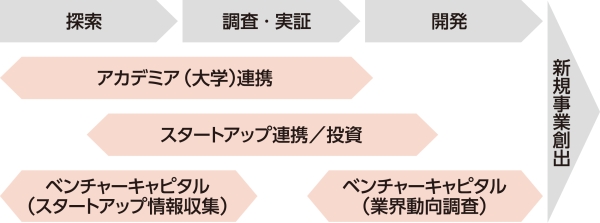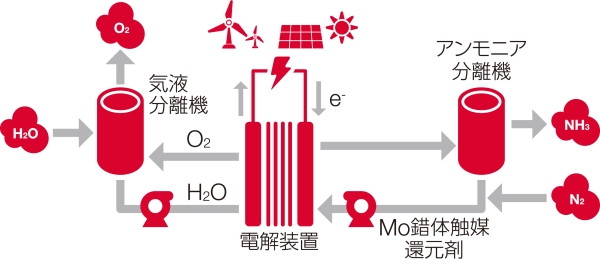Innovation management (research and development)
Basic approach
Idemitsu Kosan has set key challenges such as "contributing to a carbon-neutral, recycling-oriented society" and "contributing to local communities (energy & mobility)," and has developed a strategy that combines the technologies of the entire company and also utilizes external technologies. I am.
Governance
Our group's research and development system consists of Advanced Technology Research Laboratories and laboratories for each department, which are responsible for specialized development. We have also established a company-wide research and development committee, which not only examines direction and strategy, but also strengthens collaboration between laboratories and improves technological capabilities.
Strategy
Our group aims to create new businesses that take into account changes in society, the diversification of customer needs, and the reduction of environmental impact. Our strategy is to consolidate company-wide technologies and proactively utilize external technologies to achieve early realization. I am drawing. Technological innovation is essential to achieving the goals of the Paris Agreement, an international framework on climate change. Our group will continue to leverage the technological development capabilities we have cultivated over many years in various fields to create innovations that contribute to solving various social issues, including climate change.
Initiatives
Research and development investment results
Our group is engaged in research and development for Petroleum, Functional materials, Resources, and even new business creation. We carry out research and development activities in close cooperation with each other under our research and development system.
●Research and development investment amount results in FY2022 (unit: million yen)
| Research and development expenses | 23,640 | |
|---|---|---|
| Breakdown by segment | Petroleum | 396 |
| Functional Materials | 12,703 | |
| Power/Renewable energy | 258 | |
| Resources | 368 | |
| Others | 9,914 | |
Strengthening activities to create new businesses
In the early stages of research and development, such as exploration and research, which are the key to creating new business, we not only engage in cross-internal activities that utilize our own technology and knowledge, but also actively collaborate with outside parties to promote openness. With innovation at the center of our efforts, we are working to accelerate the creation of new businesses to transform our business portfolio.
Promoting open innovation
Utilizing funds managed by venture capital *1, we are collaborating with start-up companies in Japan and overseas. For example, in Bio-Life Solutions, we invested in Bacchus BioInnovation in April 2023 and started working on smart cell development.
Through the activities of the "Idemitsu Kosan Collaborative Research Center for the Creation of Next-Generation Materials," which was established at Tokyo institute of technology in 2020, we will work with Tokyo tech to acquire technologies in the advanced materials field and the CNX *2 solution field. The project resulted in five patent applications and four conference presentations. In order to further expand business creation, we will establish a joint research department with Kobe university in 2023 and begin academic collaboration with the university of California, Santa Barbara, etc.
*1 Universal Materials Incubator (Headquarters: Japan), Emerald Technology Ventures (Headquarters: Switzerland), Azimuth Capital Management (Headquarters: Canada), Hatch Blue (Headquarters: Ireland)
*2 CNX: Carbon Neutral Transformation
Theme creation through cross-departmental initiatives
Our activities to create medium- to long-term new business themes (advanced materials project) are in their third year, and we continue to mobilize the wisdom of a total of 30 people. The themes created through these initiatives are not limited to internal consideration, but are also promoted through collaboration with universities and startups to materialize business plans. Through these initiatives, we are also continuing to develop co-creative innovation human resources.
●Activities aimed at creating new business



Enhancing R&D activities through MI/DX
We are working to accelerate research and development through MI (Materials Informatics) and strengthen DX promotion.
-
Reskilling: We share examples of in-house initiatives, hold workshops to improve literacy, and implement and promote practical data science training across all laboratories.
-
DX solution development: Through collaboration with domestic and international consulting companies, we are promoting the development of solutions to solve key MI/DX issues in each R&D.
-
Environment preparation: We are preparing a company-wide dedicated data science cloud environment that can safely and flexibly utilize open databases and open source software essential for MI/DX.
Development of new ammonia (green ammonia) synthesis method
Since ammonia does not emit CO2 when burned, it is expected to be a next-generation fuel for coal-fired power generation and ships. Currently, ammonia is manufactured using the Haber-Bosch method (HB method), but because nitrogen and fossil fuel-derived hydrogen are reacted under high temperature and pressure, a large amount of CO2 is emitted during manufacturing.
Our company is participating in the NEDO* project and is proceeding with the study, and using a reducing agent developed based on the Mo catalyst developed by Professor Nishibayashi of the university of Tokyo, it is possible to generate nitrogen and water at room temperature and pressure. We discovered that ammonia is continuously generated from energy. We aim to establish an innovative technology to replace the HB method, and are proceeding with development toward practical application.
*NEDO: New Energy and Industrial Technology Development Organization



Launch of advanced materials project
In order to strengthen development and expand business in the advanced materials field, it is important to not only commercialize themes under consideration as early as possible, but also to continually create new themes. Therefore, we started the "Advanced Materials Project" in 2022 as a project activity to explore themes. By bringing together the wisdom of each division of Advanced Materials Company and thinking outside the bounds of existing business fields, we can generate ideas, develop commercial plans, and repeat verification in a short period of time, leading to the creation of new businesses in the field of advanced materials. Through this project, we will develop human resources capable of co-creation and innovation, thereby expanding the circle of change to the entire Advanced Materials Company.
Development of innovative semiconductors that combine low cost and low power consumption to meet the demand for lower power consumption due to advances in high-speed communication and digital technology
In 2006, our company began developing the polycrystalline oxide*1 semiconductor material IGO (Indium Gallium Oxide). The IGO developed by our company is characterized by its high mobility, which is on the same level as low-temperature polysilicon (LTPS)*2, which was not possible with conventional oxide semiconductors. It is suitable for processing even in large-scale lines of 8th generation and above, and is expected to contribute to the evolution of display performance, the development of the industry, and the realization of a low-carbon society by reducing the power consumption of displays.
*1 Polycrystalline oxide: A polycrystalline thin film composed of metal elements and oxygen.
*2 Low-temperature polysilicon (LTPS): Polycrystalline silicon formed on a glass substrate at low temperatures. High electron mobility.
*3 Poly-OS: Polycrystalline oxide semiconductor
Consideration of oil production from non-edible biomass raw materials with high sustainability and availability
Oils and fats are widely used as raw materials for biodiesel oil, but in recent years they are also expected to be used as raw materials for biojet fuel and bioplastics. On the other hand, competition with food uses and the destruction of tropical rainforests due to palm palm plantations are seen as problems. The use of waste cooking oil, which is said to have a low environmental impact, is progressing, but there are issues with its availability.
Therefore, we are developing a process to use the power of microorganisms to produce fats and oils from lignocellulose*, the most abundant biomass on earth. We are discovering microorganisms in nature that have the world's highest level of oil production, and are developing technology to further increase production efficiency. By commercializing the production of oils and fats using microorganisms, we aim to supply fuel raw materials and chemical raw materials with low environmental impact.
*Lignocellulose: Main component of plant cell walls
Development of new technology to promote solar power generation as a main power source
In the NEDO project "Technology Development to Promote Solar Power as a Main Power Source/Technology Development to Create New Markets for Solar Power", we are developing new technologies to expand the number of locations where solar cells can be installed. In particular, as part of the development of new technology for mounting solar cells on general electric vehicles, multiple organizations including our company are working to develop solar cell modules that can be mounted on automobiles and achieve high efficiency and low cost. We are collaborating and cooperating to implement the project. As part of the development of this solar cell module, our company is developing CIS bottom cell technology. The new technology is based on the CIS solar cell technology (a compound solar cell made of copper, indium, and selenium) developed by our group company Solar Frontier Co., Ltd. is applied.